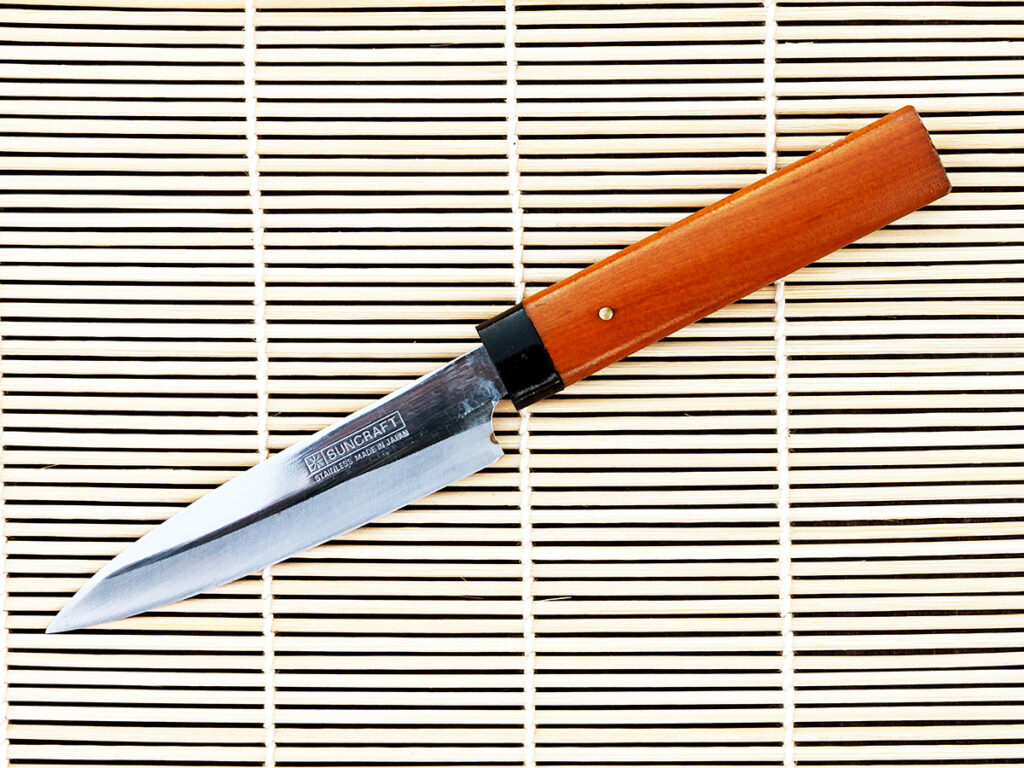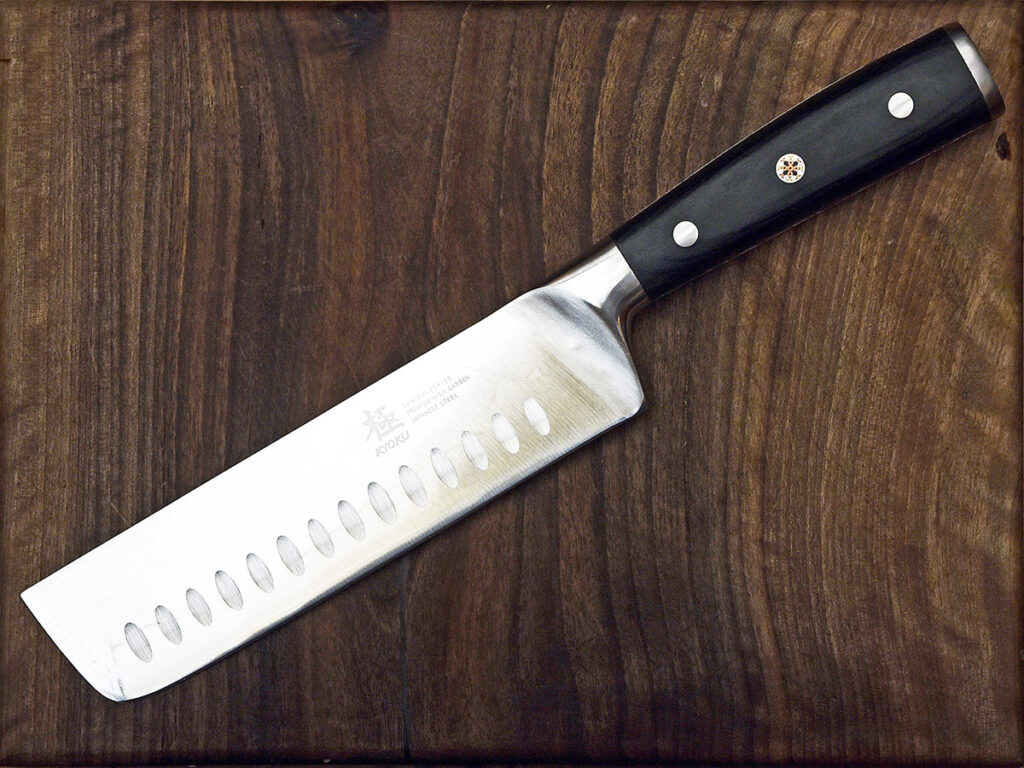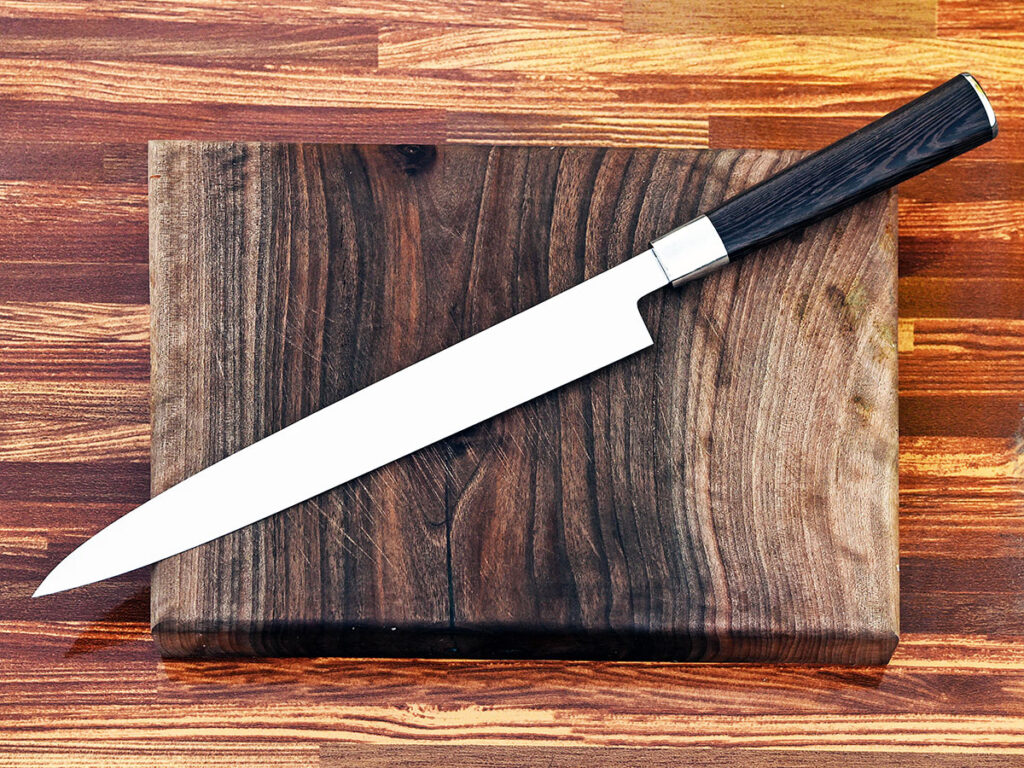At CarnivoreWeb.com, we independently review products and outfitters. However, we may earn a commission when you purchase products through links on our site. Read our affiliate policy. Read about how we test products.
A few basic tips to help you understand and maintain Japanese kitchen knives.
Whether you’re a professional or just a dedicated and serious home chef, you should look for outstanding cutting performance in your kitchen knives. This is especially true if you pride yourself on edible art that requires delicate and beautiful looks on your final presentation. For many chefs, there’s no substitute for a well-made Japanese kitchen knife.
Japanese kitchen knives have a long history full of myth and mystery. This is most likely due to Japan’s relationship with the sword. Particularly, the swords of the samurai. If there was ever a sword shrouded in mythology that defies facts to this day, it’d be the katana.
By examining the historical record, you can quickly break down these misconceptions while understanding the much-deserved reputation.

The Steel
Traditional Japanese knives are made from high carbon steel. This holds true to this day in many instances even with the rise of stainless super steels. Carbon steels historically have better edge retention properties than most stainless steels, and some chefs actually like the imparted taste of the iron in their foods.
Many times, traditional Japanese kitchen knives will be made of alloys with different blends of steel for different properties. This isn’t too unlike the manufacture of traditional Japanese swords, and there’s a reason for that: historically, Japan had never had particularly good sources of steel. Alloys had to be made to ensure blades had the right combination of sharpness, edge retention, hardness, etc.
Although carbon steel or laminated blades may be more traditional, they do require more maintenance. Modern Japanese kitchen knives are now made in stainless steels as well as other alloys to prevent corrosion, though nothing really beats the edge retention and sharpness of a laminated blade.
VG10 is a stainless steel made in Seki City, Japan, specifically for Japanese-style kitchen knives. It has all the right properties for a kitchen knife — sharpness, hardness, edge retention — and offers a good degree of corrosion resistance. Spyderco Knives makes some outstanding examples in Japan, including a series by Muteki Bladesmith Murray Carter.

The Edge
Single bevel or zero-ground knives are very popular in Japanese kitchens, especially for slicing sashimi. These knives get their name from the distinct look of having a flat side on the left-hand side of the blade to protect the chef’s fingers while slicing and dicing. Because of the lack of parasitic drag found on a conventional or Western-style kitchen knife, they excel in the kitchen regarding cutting performance.
Similarly, the clean cut translates well to food preparation by maintaining the flavors and the textures of the food. I witnessed this firsthand at a sushi counter.
It has always been my practice to order anything special the chef makes — not the special of the day, but what the chef regards as his best work. I watched him remove a piece of Ika (squid) which had always been one of my least favorites. He took that piece of squid and angled his Yanagiba, slicing it deftly. He then retrieved a smaller blade from his belt and made three slight horizontal cuts in the squid before serving it to me atop its rice, nigiri style. I never knew what he did, but it was the most flavorful piece of nigiri I ever tasted — all due to how the squid was cut and sliced.
The Handle
On a traditional Japanese chef’s knife, the handles are typically very simple and spartan. Knives are most commonly the stick tang type, as the blades are meant to be replaced when they’re ruined.
The handle is often a simple affair made of wood, and typically has a metal or plastic collar. Elaborate or expensive handles are typically made for aesthetic or artistic purposes and represent more of a Western influence. Japanese regard their kitchen knives as utilitarian tools. They may be some very expensive tools in certain instances, but tools nonetheless.
The Profile
There are scores of blade shapes and profiles found on Japanese kitchen knives. Each one is developed for a different task, so it depends how specialized you want to get in the kitchen. Most knife styles will have a relatively thin blade compared to their Western counterparts. This is for weight reduction and to keep a keener edge, but you pay a price in fragility.
The Santoku is a staple that can be used in almost any kitchen. Its name means three virtues, and this is because the knife is used on meat, fish, and vegetables or it can chop, slice, and dice. It has a sheepsfoot-style blade, which gives it a more linear cutting edge. It doesn’t make use of the single or chisel bevel, but rather a conventional V-grind more common in Western cutlery. Introduced in the postwar period of the 1940s, this is the most common knife to find in a Japanese kitchen.

Nakiri hˉochˉo or Usuba hˉochˉo refer to vegetable knives. These knives lack a tip and look like a cleaver or straight razor in shape. The Nakiri has a V-grind like the Santoku, but the Usuba is chisel ground. The lack of a tip allegedly goes back to a time when a samurai of high rank took offense to a cook pointing a blade at him while he was preparing the samurai’s dinner and knives such as these were then made without a pointed tip.

The Yanagiba is a long, thin knife used for slicing fish for sashimi or nigiri. The long blade allows for clean cuts through the entire fish in a single motion. The blade is thin to prevent bruising or tearing of the fish and the unsharpened bevel is slightly concave to prevent the fish from sticking to the knife after being cut. There are many different types in this classification for cutting different types of fish such as bonito, octopus, or fugu (blowfish). There’s even a profile called Unagisaki hˉochˉo, which is specifically designed for filleting eel.

Maintenance
It’s never a good idea to put any chef’s knife in the dishwasher because of heat and vibration, not to mention abrasive and corrosive detergents. Always wash your knives by hand with hot, soapy water and dry them down with a towel. If you use a high carbon steel blade, place a drop of olive or Tsubaki (tea seed) oil on each side of the blade after it has been washed and dried, and rub it in with a microfiber cloth to protect it.
These knives should be stored on a magnetic strip, in a block, or in an individual sheath. Do not keep them loose in a drawer with other tools that could damage the edges.
If you need to sharpen your blades, use a traditional knife sharpener in the form of diamond or ceramic sticks. Spyderco makes several of them, but if you want to truly experience the kind of edge that parts food on the molecular level, then there’s no substitute for learning to use a set of Japanese water stones. Avoid using a butcher’s steel unless it came with the knife. We’ve all seen butchers or chefs rubbing the blade of one of their knives against a steel rod and it appears that they’re honing the blade down to a fine edge. They are not. A butcher’s steel is used to smooth out dents in the edge usually caused by chopping through bone.

Should you have to use a butcher’s steel to fix a rolled or dented edge, make sure it’s made of the same steel and hardness of the blade. Otherwise, you’ll simply ruin your blade.
Having a set of traditional Japanese chef’s knives is a must if you want to take your food prep and meal presentation to the next level. They may not be suitable for heavy chopping or butchering on bones or frozen foods, but plenty of other knives and cleavers are suitable for that type of work.
Think of them as you would the paintbrush of an artist for the final finish.
Editor’s Note: This article originally appeared in Carnivore Magazine Issue 10.
More Knives & Blades
- Top General-Purpose Fixed Blades
- Fold Rush!: Top Folding Saws
- Osprey Knives Review: K2 Raptor & Warthog Field Tested
- Japanese Kitchen Knife Basics
- Get Sharp: Work Sharp’s Ken Onion Edition Knife & Tool Sharpener Mk.2
Why You Can Trust CARNIVORE
Since its launch, CarnivoreWeb.com has been a trusted authority on hunting, fishing and wild food, delivering expert insight for outdoorsmen who live the field-to-table lifestyle. More than a hunting and fishing site, CarnivoreWeb.com covers the full spectrum of the modern outdoors—from rifles, bows, and fishing gear to cooking, conservation and adventure.
Our contributors are drawn from across the hunting and angling world, including seasoned guides, lifelong hunters, competitive shooters and outdoor writers with decades of field experience. Every review, article and feature is built on firsthand testing, deep research, and an unwavering commitment to accuracy.
Commitment to Journalistic Principles
At CarnivoreWeb.com, upholding journalistic integrity is our top priority. We follow strict editorial standards to ensure all content is accurate, transparent, and unbiased. Our editors and writers operate independently, free from outside influence, advertisers or stakeholders. We adhere to established journalistic codes of ethics, holding ourselves accountable for the information we publish, correcting errors when they occur and disclosing any potential conflicts of interest.
This commitment ensures that our readers can trust CarnivoreWeb.com to provide reliable, honest coverage that helps them make informed decisions—whether selecting gear, honing outdoor skills or preparing wild game.
Find out more about our Editorial Standards and Evaluation Process


